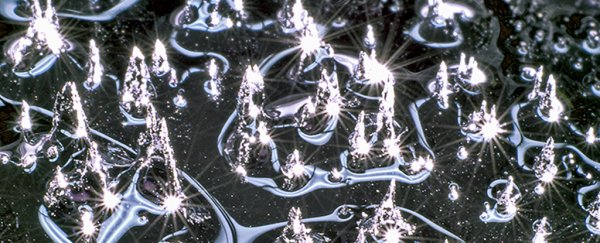Researchers have developed a new material from liquid metal and magnetic particles, and it could help us uncover some of the mysteries of our planet's magnetic field.
The material has the potential to reproduce conditions found at the cores of planets and stars, giving scientists the opportunity to study these phenomena in the lab without having to drill down into the centre of Earth, or some other planet.
With the added ingredient of suspended magnetic particles, the material has the ability to generate and manipulate magnetic fields up to five times stronger than those generated by liquid metal on its own, say researchers from Yale University.
That's important, because despite the fact that our planet's magnetic field protects us from the harsh conditions of space, we still don't really understand how it works - or why our magnetic poles have a tendency to flip every few hundred thousand years or so.
To model what's going on, the researchers combined an alloy of indium and gallium called eGaIn with various magnetic and nonmagnetic particles, including iron and zinc.
The liquid metal was also treated with an acid solution to prevent oxidation, and also to allow the added particles to fully submerge into the metal.
"We managed to suspend almost anything we wanted - steel, zinc, nickel, iron - basically anything with a conductivity higher than that of the eGaIn," said one of the researchers, Florian Carle.
With higher electrical conductivity, and greater capability for manipulating magnetic fields, the material will give scientists the chance to study more closely the effects of magnetohydrodynamics - magnetic properties of conductive fluids that you'd usually have to cut open a planet or star to see.
That means we can now reproduce in the lab some of the same liquid metal and magnetic field conditions happening at the core of our planet. In the words of Carle, it gives us the chance to "create a smaller Earth" in the lab.
Scientists have tried to model Earth's core before, primarily using explosive liquid sodium, but the team says its material is easier to manipulate, and works on a smaller scale - a few centimetres, rather than several metres.
One of the first things they'll be looking into next is what causes Earth's magnetic poles to reverse - with magnetic south and magnetic north expected to change every few hundred thousand years.
Scientists think it's something to do with the flow of liquid metal in Earth's core, but have previously had to rely on computer simulations to try and figure out what's going on.
The new liquid metal material should enable them to better test this hypothesis, and get a clearer understanding of when the next pole reversal migh occur, and what the effect might be.
The researchers will also get more insight into how Earth's magnetic field protects us from space radiation, and how sturdy that shield really is.
The findings have been published in Physical Review Fluids.
